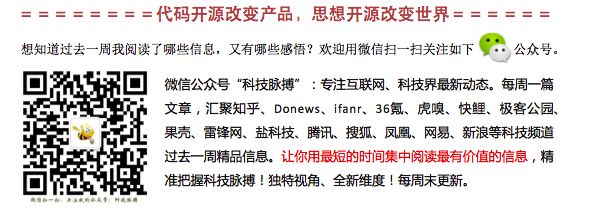UIImage 详解
UIKit中有一些类可以用来操纵单个图像,还有一个图像类可以用来显示图像。Apple还提供了一种特殊的导航控制器,用于从图像库中选择图像。 UIImage类对图像及其底层数据进行封装。它可以直接绘制在一个视图内,或者作为一个图像容器在另一个更大的图像视图容器中使用。这个类类提供的方法可以用来从各种来源中载入图像,在屏幕上设置图片的方向,以及提供有关图像的信息。对于简单的图形应用,可以将UIImage对象用在视图类的drawRect方法中,用来绘制图像和团模板。 你可以用文件来初始化,也可以用url、原始数据、或者一个Core Graphics图像的内容。静态方法(类方法)和实例方法都有;这些方法可以引用并缓存已有的图像内容,也可以实例化新的图像对象,如何使用完全取决于应用程序的需要。 使用一个图像的最简单方法就是通过静态方法。静态方法不会去管理图像的实例,与之相反,他们提供了直接的接口,可以用来共享位于框架内部的记忆体缓存对象。这有助于保持应用程序的整洁,也会生去做清理工作的需要。静态方法和实例方法都可以用来创建相同的对象。 一、使用文件创建(静态方法) UIImage *myImage = [UIImage imageNamed:@"ppp"]; 二、使用 URL 和原始数据(静态方法) NSData *imageData = [ NSData initWithBytes:image:imagePtr length:imageSize ]; // 假设 imagePtr 是一个指向原始数据的指针 UIImage* myImage = [ [ UIImage alloc ]initWithData:imageData ]; UIImage *myImage2 =[UIImage imageWithData:[NSData dataWithContentsOfURL:[NSURL URLWithString:@"http://www.kutx.cn/xiaotupian/icons/png/200803/20080327095245737.png"]]]; 三、使用Core Graphics (静态方法) UIImage* myImage3 = [UIImage imageWithCGImage:myCGImageRef]; 四、使用文件(实例方法) UIImage* myImage4 = [[UIImage alloc]initWithContentsOfFile:[NSString stringWithFormat:@"%@/Documents/ppp.png",NSHomeDirectory()]]; 五、使用 URL 和原始数据(实例方法) 如果图像存储在内存中,你可以创建一个NSData 对象作为initWithData 方法的原始输入,来初始化一个UIImage对象。 如果图像是一张网络图片,可以使用NSData来进行预载,然后用它来初始化UIImage对象: UIImage *myImage5 =[ [ UIImage alloc]initWithData: [NSData dataWithContentsOfURL:[NSURL URLWithString:@"http://www.kutx.cn/xiaotupian/icons/png/200803/20080327095245737.png"]] ]; 六、使用Core Graphics (实例方法) UIImage* myImage6 = [[UIImage alloc]initWithCGImage:myCGImageRef]; 七、显示图像 当视图类的drawRect 方法被唤起时,它们会调用内部的回吐例程。与其他图像类不同,UIImage对象不能被当成子 ,直接附着在其他视图上,因为他不是一个视图类。反过来,一个UIView类则可以在视图的drawRect例程中,调用图像的 drawRect 方法。这可以使得图像显在UIView类的显示区域内部。 只要一个视图对象的窗口的某些部分需要绘制,就可以调用它的drawRect方法。要在窗口内 部显示一个 UIImage 的内容,可以调用该对象的 drawRect 方法: - (void)drawRect:(CGRect)rect{ CGRect myRect; myRect.origin.x = 0.0 ; myRect.origin.y = 0.0; myRect.size = myImage.size; [myImage drawInRect:myRect]; } 注意不要在drawRect方法内分配任何新对象,因为他在每次窗口重绘时都被调用。 只有在视图初次绘制时,才会调用drawRect方法。要强制更新,可以使用视图类的 setNeedsDisplay 或者 setNeedsDisplayInRect 方法: [myView setNeedsDisplay]; [myView setNeedsDisplayInRect:self.view]; 八、绘制图案 如果图像是一个图案模板,你可以用UIImage类提供的另外一个方法 drawAsPatternInrect,在整个视图区域重复绘制该图像: UIView* myView = [[UIView alloc]initWithFrame:CGRectMake(0, 0, 200, 200)]; [myImage drawInRect:myView.frame]; [self.view addSubview:myView]; 九、方向 一个图像的方向,决定了它在屏幕上如何被旋转。因为iPhone 能被以6种不同的方式握持,所以在方向改变时,能够将图像做相应的旋转就十分必要了。UIImage 有个只读属性 imageOrientation 来标识它的方向。 UIImageOrientation myOrientation = myImage.imageOrientation ; 可以设置以下方向: typedef enum { UIImageOrientationUp, // default orientation 默认方向 UIImageOrientationDown, // 180 deg rotation 旋转180度 UIImageOrientationLeft, // 90 deg CCW 逆时针旋转90度 UIImageOrientationRight, // 90 deg CW 顺时针旋转90度 UIImageOrientationUpMirrored, // as above but image mirrored along other axis. horizontal flip 向上水平翻转 UIImageOrientationDownMirrored, // horizontal flip 向下水平翻转 UIImageOrientationLeftMirrored, // vertical flip 逆时针旋转90度,垂直翻转 UIImageOrientationRightMirrored, // vertical flip 顺时针旋转90度,垂直翻转 } UIImageOrientation; 十、图像尺寸 你可以通过size属性读取一个图像的尺寸,得到一个CGSize 结构,其中包含 wifth 和height 。 CGSize myImageSize = myImage.size; 原文链接:http://blog.csdn.net/iukey/article/details/7308433 标签: <无> 补充话题说明» 分享到 收藏0举报踩 0 | 顶 0 按默认排序 | 显示最新评论 | 回页面顶部
转:http://blog.csdn.net/iukey/article/details/7308433
为uiimage 绘制 毛玻璃效果
需要导入Accelerate.framework。
#import <Accelerate/Accelerate.h>
//加模糊效果,image是图片,blur是模糊度 - (UIImage *)blurryImage:(UIImage *)image withBlurLevel:(CGFloat)blur
{
if (image==nil)
{
NSLog(@"error:为图片添加模糊效果时,未能获取原始图片");
return nil;
}
//模糊度, if ((blur < 0.1f) || (blur > 2.0f)) { blur = 0.5f; } //boxSize必须大于0 int boxSize = (int)(blur * 100); boxSize -= (boxSize % 2) + 1; NSLog(@"boxSize:%i",boxSize); //图像处理 CGImageRef img = image.CGImage; //需要引入#import <Accelerate/Accelerate.h> /* This document describes the Accelerate Framework, which contains C APIs for vector and matrix math, digital signal processing, large number handling, and image processing. 本文档介绍了Accelerate Framework,其中包含C语言应用程序接口(API)的向量和矩阵数学,数字信号处理,大量处理和图像处理。 */ //图像缓存,输入缓存,输出缓存 vImage_Buffer inBuffer, outBuffer; vImage_Error error; //像素缓存 void *pixelBuffer; //数据源提供者,Defines an opaque type that supplies Quartz with data. CGDataProviderRef inProvider = CGImageGetDataProvider(img); // provider’s data. CFDataRef inBitmapData = CGDataProviderCopyData(inProvider); //宽,高,字节/行,data inBuffer.width = CGImageGetWidth(img); inBuffer.height = CGImageGetHeight(img); inBuffer.rowBytes = CGImageGetBytesPerRow(img); inBuffer.data = (void*)CFDataGetBytePtr(inBitmapData); //像数缓存,字节行*图片高 pixelBuffer = malloc(CGImageGetBytesPerRow(img) * CGImageGetHeight(img)); outBuffer.data = pixelBuffer; outBuffer.width = CGImageGetWidth(img); outBuffer.height = CGImageGetHeight(img); outBuffer.rowBytes = CGImageGetBytesPerRow(img); // 第三个中间的缓存区,抗锯齿的效果 void *pixelBuffer2 = malloc(CGImageGetBytesPerRow(img) * CGImageGetHeight(img)); vImage_Buffer outBuffer2; outBuffer2.data = pixelBuffer2; outBuffer2.width = CGImageGetWidth(img); outBuffer2.height = CGImageGetHeight(img); outBuffer2.rowBytes = CGImageGetBytesPerRow(img); //Convolves a region of interest within an ARGB8888 source image by an implicit M x N kernel that has the effect of a box filter. error = vImageBoxConvolve_ARGB8888(&inBuffer, &outBuffer2, NULL, 0, 0, boxSize, boxSize, NULL, kvImageEdgeExtend); error = vImageBoxConvolve_ARGB8888(&outBuffer2, &inBuffer, NULL, 0, 0, boxSize, boxSize, NULL, kvImageEdgeExtend); error = vImageBoxConvolve_ARGB8888(&inBuffer, &outBuffer, NULL, 0, 0, boxSize, boxSize, NULL, kvImageEdgeExtend); if (error) { NSLog(@"error from convolution %ld", error); } // NSLog(@"字节组成部分:%zu",CGImageGetBitsPerComponent(img)); //颜色空间DeviceRGB CGColorSpaceRef colorSpace = CGColorSpaceCreateDeviceRGB(); //用图片创建上下文,CGImageGetBitsPerComponent(img),7,8 CGContextRef ctx = CGBitmapContextCreate( outBuffer.data, outBuffer.width, outBuffer.height, 8, outBuffer.rowBytes, colorSpace, CGImageGetBitmapInfo(image.CGImage)); //根据上下文,处理过的图片,重新组件 CGImageRef imageRef = CGBitmapContextCreateImage (ctx); UIImage *returnImage = [UIImage imageWithCGImage:imageRef]; //clean up CGContextRelease(ctx); CGColorSpaceRelease(colorSpace); free(pixelBuffer); free(pixelBuffer2); CFRelease(inBitmapData); //CGColorSpaceRelease(colorSpace); //多余的释放 CGImageRelease(imageRef); return returnImage; }
参考:http://blog.csdn.net/rhljiayou/article/details/10232003 有效果图
http://www.zhihu.com/question/21260575 知乎上的讨论,比较全面
http://prolove10.blog.163.com/blog/static/138411843201391401054305/
uiimage 转 nsdata
-(NSData *)getCoverImageDataWith:(NSString *)imgeUrl { NSURL *aUrl = [[NSURL alloc]initWithString:imgeUrl]; NSData *aData = [[NSData alloc]initWithContentsOfURL:aUrl]; if (aData==nil) { aData = [UIImagePNGRepresentation([UIImage imageNamed:@"image_default"]) retain]; } SQRelease(aUrl) return [aData autorelease]; }
